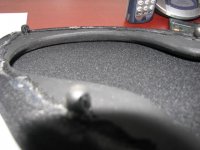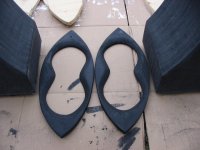I've often wondered about this. We seem to make great strides in speaker cabinet design, but stick to the same old tried and dis-proven designs for Grill Cloth Frames. See attached diagram.
I suspect for many of us, our first speaker grill looked something like 'A'. We simply took some left over boards, and made a rectangular frame.
Later we moved to type 'B' thinking the soft curved edges made it aesthetically more pleasing. But really would type 'C' with the quarter round to the inside make the transition of moving air less of a problem?
And, though not shown, wouldn't the use of half-round rather than quarter round be better still?
And would a picture frame type molding as seen in diagram 'D' be better for all, with a soft smooth rounded transition to the outer edge followed by a soft rounded transition on the outer edge? Wouldn't this ease the transition of moving air across that boundary.
Diagram 'E' is my crude attempt to draw an idea I had where the removable frame the holds the grill cloth (squares in corners) was actually flush with the front, and some perforated metal or plastic was formed into an arch to hold the cloth away from the baffle. The perforated metal (or plastic) would not run the full length, it would be placed at the top and bottom, and perhaps in the middle, away from blocking any speaker, just to hold the cloth away from the front.
With all the woodworking and speaker building skill and experience in this group, I'm amazed that someone hasn't come up with a better way of making grill frame, especially when we know there is a problem with edge defraction when the sound passes over a sharp edge.
I suppose one solution, and probably the best solution, is to not use grill cloth or grill frames, but in a world full of dogs, cats, kids, and wives, is that really a practical solution?
So, I'm curious whether anyone has tried any innovative grill frame designs, and curious how they were to build, and how the final result worked.
Steve/bluewizard
I suspect for many of us, our first speaker grill looked something like 'A'. We simply took some left over boards, and made a rectangular frame.
Later we moved to type 'B' thinking the soft curved edges made it aesthetically more pleasing. But really would type 'C' with the quarter round to the inside make the transition of moving air less of a problem?
And, though not shown, wouldn't the use of half-round rather than quarter round be better still?
And would a picture frame type molding as seen in diagram 'D' be better for all, with a soft smooth rounded transition to the outer edge followed by a soft rounded transition on the outer edge? Wouldn't this ease the transition of moving air across that boundary.
Diagram 'E' is my crude attempt to draw an idea I had where the removable frame the holds the grill cloth (squares in corners) was actually flush with the front, and some perforated metal or plastic was formed into an arch to hold the cloth away from the baffle. The perforated metal (or plastic) would not run the full length, it would be placed at the top and bottom, and perhaps in the middle, away from blocking any speaker, just to hold the cloth away from the front.
With all the woodworking and speaker building skill and experience in this group, I'm amazed that someone hasn't come up with a better way of making grill frame, especially when we know there is a problem with edge defraction when the sound passes over a sharp edge.
I suppose one solution, and probably the best solution, is to not use grill cloth or grill frames, but in a world full of dogs, cats, kids, and wives, is that really a practical solution?
So, I'm curious whether anyone has tried any innovative grill frame designs, and curious how they were to build, and how the final result worked.
Steve/bluewizard
An externally hosted image should be here but it was not working when we last tested it.
In a sense, 'C' and 'D' almost create something of a horn effect; gently, hopefully, unloading the sound.
But I wonder if the sound passing over the crest of the curve in the 'D' model doesn't see that crest the same as a sharp edge?
Again, I'm just wondering why, when we know the 'B' version has real drawbacks, no one has come up with something better.
People strive to great lengths, rounding, recessing, and beveling, to make the cabinets sound right, only to compromise all that work by adding type-B speaker grills?
I have a pair of JBL towers that use a one piece molded plastic grills that have something of a diamond pattern to them. The advantages are that the edges of the frame are very narrow, but they are also very sharp. Also, all those criss-crossing diamond shapes are all sharp edges.
One drawback to the Type-D is that it might encroach into the space of the woofers. People are making cabinet fronts narrower and narrower. Still a person could so something like you did and cut into the 'picture frame' to make room, the soften the edges by smoothing, beveling, and rounding them.
Unless I am mistaken the edge diffraction is more of a high frequency problem.
Just curious.
Steve/bluewizard
But I wonder if the sound passing over the crest of the curve in the 'D' model doesn't see that crest the same as a sharp edge?
Again, I'm just wondering why, when we know the 'B' version has real drawbacks, no one has come up with something better.
People strive to great lengths, rounding, recessing, and beveling, to make the cabinets sound right, only to compromise all that work by adding type-B speaker grills?
I have a pair of JBL towers that use a one piece molded plastic grills that have something of a diamond pattern to them. The advantages are that the edges of the frame are very narrow, but they are also very sharp. Also, all those criss-crossing diamond shapes are all sharp edges.
One drawback to the Type-D is that it might encroach into the space of the woofers. People are making cabinet fronts narrower and narrower. Still a person could so something like you did and cut into the 'picture frame' to make room, the soften the edges by smoothing, beveling, and rounding them.
Unless I am mistaken the edge diffraction is more of a high frequency problem.
Just curious.
Steve/bluewizard
- Status
- This old topic is closed. If you want to reopen this topic, contact a moderator using the "Report Post" button.

